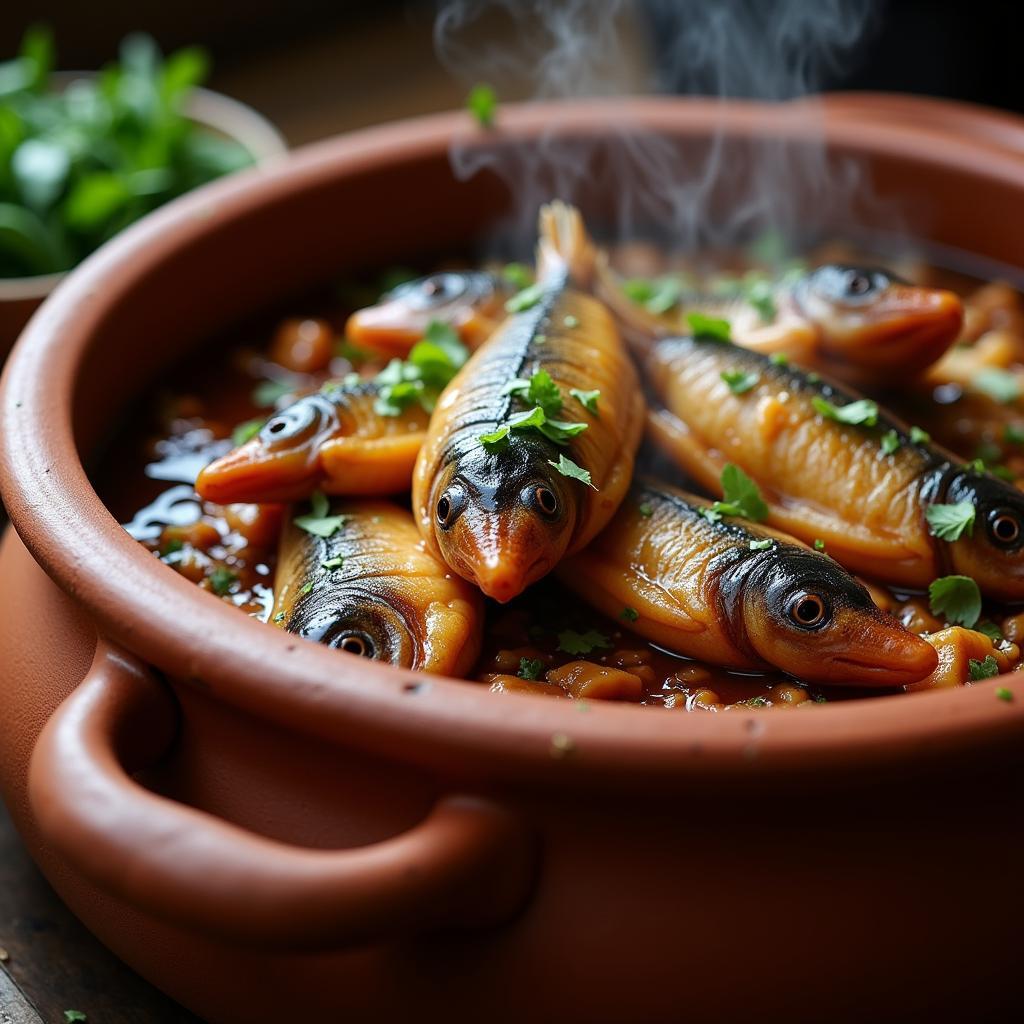Cá kèo kho tộ, a beloved Vietnamese dish, has a rich, savory flavor that captivates many. But what is it called in English? Finding the perfect English translation can be tricky. This article explores the nuances of translating “cá kèo kho tộ” and provides helpful alternatives for describing this delectable dish to English speakers.
So, what is the exact English translation for “cá kèo kho tộ”? While a direct, literal translation doesn’t quite capture the essence of the dish, “braised goby fish in clay pot” comes closest. However, this can be quite clunky. “Caramelized goby fish” offers a more succinct option, highlighting the characteristic caramelized sauce. “Clay pot goby” also works, emphasizing the traditional cooking method. Understanding the context and your audience will help you choose the most appropriate translation. For example, when talking to someone unfamiliar with Vietnamese cuisine, a descriptive phrase like “braised goby fish with caramelized sauce” might be better. Alternatively, if you are talking to someone who is familiar with East Asian cooking methods, “clay pot goby” may be sufficient. Even if you do soi kèo bóng đá ngoại hạng anh ngày mai, knowing the English translation for this popular dish can be very useful!
Understanding the Components of “Cá Kèo Kho Tộ”
To accurately translate “cá kèo kho tộ,” it’s essential to understand its components. “Cá kèo” refers to goby fish, a small, freshwater fish commonly found in Southern Vietnam. “Kho tộ” describes the cooking method: braising in a clay pot with a rich, caramelized sauce made from fish sauce, sugar, and other spices.
Why a Direct Translation Isn’t Always Best
Directly translating “cá kèo kho tộ” can result in awkward phrasing that doesn’t convey the dish’s essence. “Braised goby fish in clay pot,” while technically correct, lacks the evocative power of the original Vietnamese phrase. It’s akin to translating “pho” as “beef noodle soup”—technically accurate but missing the cultural and culinary significance.
Alternative Translations and Descriptions
Several alternative translations and descriptions capture the spirit of “cá kèo kho tộ” more effectively. “Caramelized goby fish” emphasizes the key flavor profile. “Clay pot goby” focuses on the traditional cooking method. “Braised goby fish with caramelized sauce” provides a more detailed description for those unfamiliar with Vietnamese cuisine. It’s crucial to consider the context and your audience when choosing the best translation. Do you often follow the kèo ý và áo matches? Discussing this dish can enhance your football conversations.
 Cá kèo kho tộ – Món ăn ngon
Cá kèo kho tộ – Món ăn ngon
Communicating the Flavor Profile
Describing the flavor profile is essential for conveying the deliciousness of “cá kèo kho tộ.” The dish is characterized by a sweet, savory, and slightly salty taste. The caramelized sauce adds a depth of flavor, while the fish remains tender and flaky. Mentioning these key elements helps English speakers appreciate the dish’s unique qualities.
The Cultural Significance of Cá Kèo Kho Tộ
Cá kèo kho tộ is more than just a dish; it represents a culinary tradition. It’s often served with rice and other Vietnamese staples, creating a harmonious blend of flavors and textures. Sharing this cultural context adds another layer of appreciation for the dish.
 Cá kèo kho tộ – Bữa ăn gia đình
Cá kèo kho tộ – Bữa ăn gia đình
Chef Nguyen Thi Lan, a renowned Vietnamese chef, explains, “Cá kèo kho tộ is a dish that brings people together. It’s a taste of home, a reminder of family gatherings and celebrations.”
Adapting the Dish for Western Palates
While the authentic version is often preferred, adapting “cá kèo kho tộ” for Western palates is possible. Reducing the amount of fish sauce or adjusting the sweetness can cater to different taste preferences.
Chef Le Van Phuong, a culinary instructor specializing in Vietnamese cuisine, adds, “Adapting traditional dishes allows more people to experience the flavors of Vietnam, while still respecting the original recipe’s integrity.”
Knowing whether to soi kèo Celtic vs or follow another match can be challenging. Sometimes, a comforting meal like this is exactly what’s needed! Ultimately, the best English translation for “cá kèo kho tộ” depends on the context and audience. Whether you choose “caramelized goby fish,” “clay pot goby,” or a more descriptive phrase, communicating the dish’s unique flavors and cultural significance is key.
Conclusion
“Cá Kèo Kho Tộ Tiếng Anh Là Gì?” – a seemingly simple question with a multifaceted answer. By understanding the nuances of the dish and adapting the translation to your audience, you can effectively share the culinary delight of this Vietnamese classic. Remember to highlight its delicious caramelized flavor and the traditional cooking method.
FAQ
- What type of fish is used in cá kèo kho tộ? Goby fish.
- What does “kho tộ” mean? Braising in a clay pot.
- Is cá kèo kho tộ spicy? No, it is sweet, savory, and slightly salty.
- What is the best English translation for “cá kèo kho tộ”? It depends on the context, but “caramelized goby fish” or “clay pot goby” are good options.
- Can I adapt the recipe for Western palates? Yes, you can adjust the seasoning to suit different preferences.
- Where can I find goby fish? Asian markets are your best bet.
- What is typically served with cá kèo kho tộ? Rice and other Vietnamese side dishes.
Other related topics: kèo đức và nhật, kèo Man City vs
Khi cần hỗ trợ hãy liên hệ Số Điện Thoại: 0938844703, Email: [email protected] Hoặc đến địa chỉ: 227-229 Đ. Số 1, Bình Trị Đông B, Bình Tân, Hồ Chí Minh, Việt Nam. Chúng tôi có đội ngũ chăm sóc khách hàng 24/7.